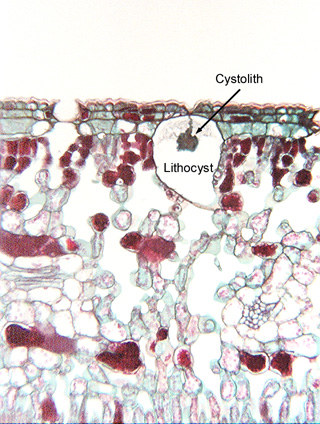 Fig.
10.5-1. Transverse section of fig leaf (Ficus). The feature to
notice here is the large cell – a lithocyst
(“rock cell”) which contains a cystolith
(a “cell rock”). Although the lithocyst appears to be a large mesophyll
cell, it actually is a giant epidermis cell that protrudes into the mesophyll.
The cell is so large that the microtome knife can cut it into many sections, and
usually only the central one or two sections show the upper tip of the cell,
which is actually located among the ordinary epidermis cells.
Fig.
10.5-1. Transverse section of fig leaf (Ficus). The feature to
notice here is the large cell – a lithocyst
(“rock cell”) which contains a cystolith
(a “cell rock”). Although the lithocyst appears to be a large mesophyll
cell, it actually is a giant epidermis cell that protrudes into the mesophyll.
The cell is so large that the microtome knife can cut it into many sections, and
usually only the central one or two sections show the upper tip of the cell,
which is actually located among the ordinary epidermis cells.